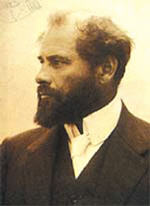
Gustav Klimt was born in Baumgarten, near Vienna, Austria. He was educated at the Vienna Kunstgewerbe Art School in the years 1879-1883. Klimt was also an honorary member of the Universities of Munich and Vienna. His major works include paintings, murals, sketches and other art objects, many of which are on display in the Vienna Secession gallery. His work is distinguished by an elegant use of gold backgrounds and mosaic patterns. This can be seen in Judith I (1901), and in The Kiss (1907). Art historians note an eclectic range of influences contributing to Klimt's distinct style, including Egyptian, Minoan, Classical Greek, and Byzantine inspirations. Klimt was also inspired by engravings of Albrecht Dürer, late medieval European painting, and Japanese Ukiyo-e. Klimt was one of the founding members of the Wiener Sezession (Vienna Secession) and of the periodical Ver Sacrum. He left the movement in 1908. He died in Vienna of pneumonia and was interred at the Hietzing Cemetery, Vienna.